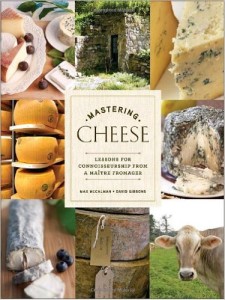 I am a cheese fiend. Along with coffee and chocolate, those make up the 3 C’s of my diet some days; so it’s rather nice to be able to put cheese back onto the “healthy” side of the line after reading Mastering Cheese: Lessons for Connoisseurship From a Maître Fromager. Perhaps not surprisingly for a maître fromager (cheese expert), McCalman (whose writing, along with that of his co-author, Gibbons, has been nominated for the James Beard Award in the past) comes down firmly on the side of cheese as nutritious food:
I am a cheese fiend. Along with coffee and chocolate, those make up the 3 C’s of my diet some days; so it’s rather nice to be able to put cheese back onto the “healthy” side of the line after reading Mastering Cheese: Lessons for Connoisseurship From a Maître Fromager. Perhaps not surprisingly for a maître fromager (cheese expert), McCalman (whose writing, along with that of his co-author, Gibbons, has been nominated for the James Beard Award in the past) comes down firmly on the side of cheese as nutritious food:
Cheese is a delicious and tremendously efficient course of nutrition. It supplies many valuable nutrients, including proteins, sugars, vitamins, minerals, and trace elements. A 4-ounce piece of solid farmhouse cheese, for example, supplies more than half the adult nutritional requirements for protein, fat, calcium, and phosphorus as well as significant portions of vitamins A, B2, and B12.
Well, that’s a relief. Only one wrinkle: he’s not talking about the store-brand cheap stuff most of us pick up once a week, but the artisanal versions. The stuff I look at and wish I could afford. And this book makes me want to afford it all the more.
McCalman sings the praises of artisanal cheese and cheese-making in this book even as he instructs the reader on terminology, history, and current food politics, supporting it all with vivid and well-placed photos. The writing style is fluid and in some spots wry, and filled from start to finish with an unabashed love for his work:
Although I will not back down from my assertion that raw milk makes better cheese, this does not rule out the possibility of very good cheeses being made from pasteurized milk…If you’d like to taste and judge for yourself, I can suggest…examples of potentially great cheeses made from pasteurized milk.
Mastering Cheese is intended as a guide for beginners, and as one myself, I declare it an eminently worthy attempt. It steadily and logically covers everything there is to get an enthusiast started. Part One, titled “Understanding Real Cheese,” moves through basic terminology, history, basic steps, flavor, how to assess a cheese, a discussion of particular breeds of cow or sheep–even how the time of year the milk comes from affects the end product. McCalman closes out the first part Mastering Cheese, McCalman/Gibbonsof the book by talking about raw milk vs. pasteurized, then, moving on into Part Two, “Becoming a Connoisseur”, details a visit to a Connecticut cheese farm, explains what to look for when buying cheese from a specialty shop, how to build a cheese platter for use in a restaurant or at home, and discusses pairing cheese with wines and beers. Then we’re into Part Three, “Great Artisan Cheeses of the World”, which moves from American artisan cheeses around the world and through the gamut of cheese types, from cheddars to chevres.
That all might sound dry, but trust me–if you are anything like me (that is, an adoring, drooling fan of a great cheese platter), you’ll enjoy the read. It doesn’t need to be read sequentially; I skipped around from section to section as the mood struck me, as I usually do with non-fiction books, and it still made perfect sense.
The four appendices aren’t to be skipped, either; they cover, in turn, “Cheese Appellations” (with a hefty dash of history thrown in there), a listing of “United States Artisan Farmstead Cheese Producers” (a surprisingly long list), a listing of “Courses, Conferences, Conventions, and Organizations” (which I do believe I’ll be paying close attention to), and “An Index to the Fine Cheeses of the World” (a summarized listing of the cheeses mentioned throughout the text plus a double handful more).
This is a terrific reference book for beginners, and a great jumping off point for those who want to take their study of cheese further. I certainly learned–and will even remember, a rare mark of distinction–quite a bit from this book, not least of which is that I’m not alone in my adoration of cheesy stuff. And now, if you’ll excuse me, I have to go see a fromager about a cheese….
(Clarkson Potter/Publishers, 2009)
